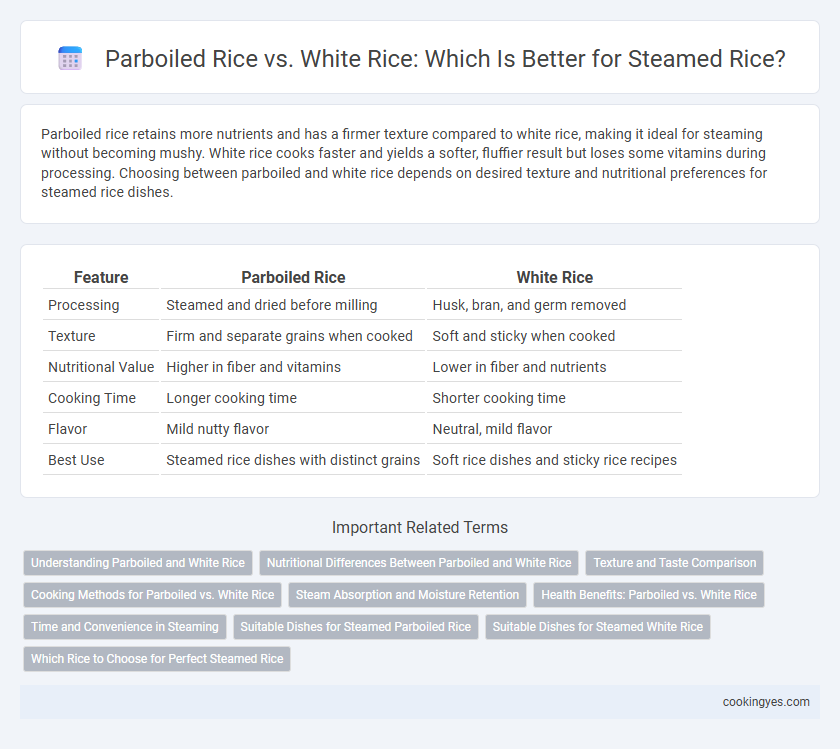Parboiled rice retains more nutrients and has a firmer texture compared to white rice, making it ideal for steaming without becoming mushy. White rice cooks faster and yields a softer, fluffier result but loses some vitamins during processing. Choosing between parboiled and white rice depends on desired texture and nutritional preferences for steamed rice dishes.
Table of Comparison
| Feature | Parboiled Rice | White Rice |
|---|---|---|
| Processing | Steamed and dried before milling | Husk, bran, and germ removed |
| Texture | Firm and separate grains when cooked | Soft and sticky when cooked |
| Nutritional Value | Higher in fiber and vitamins | Lower in fiber and nutrients |
| Cooking Time | Longer cooking time | Shorter cooking time |
| Flavor | Mild nutty flavor | Neutral, mild flavor |
| Best Use | Steamed rice dishes with distinct grains | Soft rice dishes and sticky rice recipes |
Understanding Parboiled and White Rice
Parboiled rice undergoes partial boiling in the husk, which enhances its nutritional profile by driving vitamins and minerals into the grain while increasing firmness and reducing stickiness when steamed. White rice is milled and polished, removing the bran and germ, resulting in a softer texture but lower nutritional value compared to parboiled variants. Choosing between parboiled and white rice affects cooking time, texture, and nutrient retention, with parboiled rice offering more resistance to overcooking and better keeping quality after steaming.
Nutritional Differences Between Parboiled and White Rice
Parboiled rice retains more nutrients such as vitamin B6, magnesium, and potassium due to the steaming process that drives nutrients from the bran into the grain. White rice undergoes polishing that removes the bran and germ, resulting in lower fiber, vitamins, and minerals compared to parboiled rice. The higher nutrient content in parboiled rice contributes to better blood sugar regulation and improved digestion when used for steamed rice dishes.
Texture and Taste Comparison
Parboiled rice offers a firmer, less sticky texture with a slightly nutty flavor, making it ideal for dishes where separate grains are preferred. White rice cooks softer and fluffier, providing a milder taste that complements a wide range of recipes. For steamed rice, parboiled maintains grain integrity better under moisture, while white rice delivers a lighter, more delicate mouthfeel.
Cooking Methods for Parboiled vs. White Rice
Parboiled rice requires soaking and a longer simmering time to achieve a firm texture, making it ideal for steaming methods that retain grains' separation and nutrients. White rice absorbs water quickly and cooks faster with direct steaming or boiling, resulting in a softer, stickier consistency preferred in many culinary dishes. Choosing the appropriate steaming technique depends on the desired texture and cooking duration specific to each rice type.
Steam Absorption and Moisture Retention
Parboiled rice exhibits superior steam absorption due to its partially gelatinized starch, allowing grains to swell and retain moisture effectively during steaming. In contrast, white rice typically absorbs less steam, leading to a drier texture as it lacks the structural modifications present in parboiled varieties. The enhanced moisture retention in parboiled rice results in fluffier, firmer grains that hold their shape better after cooking.
Health Benefits: Parboiled vs. White Rice
Parboiled rice retains more nutrients like vitamins B1, B3, and minerals due to its soaking and steaming process before milling, making it a healthier option compared to white rice. Its higher fiber content supports digestion and helps regulate blood sugar levels better than white rice, which loses much of its nutritional value during milling. Moreover, parboiled rice has a lower glycemic index, promoting sustained energy release and improved metabolic health in steamed rice dishes.
Time and Convenience in Steaming
Parboiled rice requires longer steaming time due to its partial boiling process but offers a firmer texture and less stickiness, making it convenient for meal prepping and reheating. White rice steams faster, typically within 15-20 minutes, providing a soft texture ideal for quick meals. Choosing between parboiled and white rice depends on balancing cooking time with desired consistency and ease of preparation.
Suitable Dishes for Steamed Parboiled Rice
Steamed parboiled rice is ideal for dishes requiring firm, separate grains such as biryanis, pilafs, and fried rice, where texture retention is crucial. Its partially boiled processing enhances nutrient retention and reduces stickiness compared to white rice, making it suitable for recipes involving stir-frying or layering. Parboiled rice's ability to absorb flavors while maintaining grain integrity complements robust spices and rich sauces often used in South Asian and Caribbean cuisines.
Suitable Dishes for Steamed White Rice
Steamed white rice is ideal for dishes where a light and fluffy texture complements the flavors, such as stir-fries, curries, and sushi. This rice variety absorbs sauces well without becoming sticky, making it perfect for Asian cuisines and Mediterranean plates. Its neutral taste and soft grain structure enhance meals like grilled meats, steamed vegetables, and seafood.
Which Rice to Choose for Perfect Steamed Rice
Parboiled rice retains more nutrients and has a firmer texture after steaming, making it ideal for recipes requiring separate, fluffy grains. White rice, commonly used for steamed rice, offers a softer, stickier texture that works well for dishes needing a cohesive, tender bite. Choose parboiled rice for healthier, non-sticky results and white rice when a classic, soft steamed rice consistency is preferred.
Parboiled vs White for steamed rice Infographic

 cookingyes.com
cookingyes.com